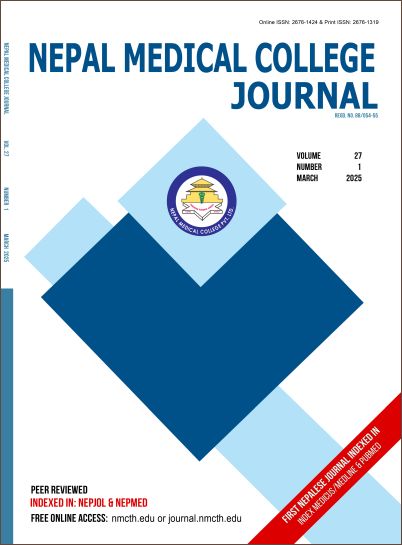Study of Antiseptic Resistance Genes and Antibiotic Resistance in Staphylococci Isolated from Hospital Staffs and Environment at a Tertiary Care Hospital, Nepal
DOI:
https://doi.org/10.3126/nmcj.v27i1.77542Keywords:
Antibiotic, antiseptic, resistance, genesAbstract
Non-susceptibility of bacteria to disinfectants/antiseptics has been reported in various countries, however, such study has not been conducted in Nepal yet. Therefore, we aimed to determine prevalence of antiseptic resistance genes (qacA/B, smr), pattern of antibiotic resistance, and association of antiseptic resistance gene with antibiotic resistance in Staphylococci isolated from hospital staffs and environment. A total of 275 non-repetitive swabs (total of 120 from health staffs: 80 from hands and 40 from nares and total 155 from hospital environment: 120 pre-swabs collected before sterilization of surfaces and 35 post-swabs collected after sterilization) were collected and subjected for culture and sensitivity. Obtained data were analyzed using Microsoft Excel. Among hospital surveillance swabs, prevalence of Staphylococci was 9.09% (25/275). Among them, 40.0% (10/25) of isolates were methicillin resistant and all methicillin resistant isolates were multidrug resistant. Prevalence of antiseptic resistance gene such as qacA/B was 48.0% and smr was 64.0%. The proportion of antibiotic resistance among positive antiseptic resistance was 62.5% which is significantly associated (p=0.003; Fisher exact test). Judicious use of disinfectants for cleaning hospital surfaces is recommended and cleaning should be done with detergent water on regular basis followed by periodic cleaning with disinfectant for most of the hospital surfaces. Regular hospital surveillance along with study of antiseptic resistance genes among isolates could be helpful for formulating policy on “antiseptic use” in Nepalese hospitals.
Downloads
Downloads
Published
How to Cite
Issue
Section
License
Copyright (c) 2025 Nepal Medical College Journal

This work is licensed under a Creative Commons Attribution 4.0 International License.
This license enables reusers to distribute, remix, adapt, and build upon the material in any medium or format, so long as attribution is given to the creator. The license allows for commercial use.




